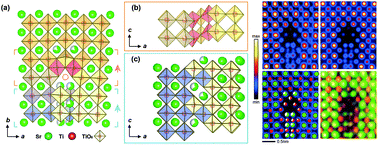当前位置:
X-MOL 学术
›
Faraday Discuss.
›
论文详情
Our official English website, www.x-mol.net, welcomes your
feedback! (Note: you will need to create a separate account there.)
Local crystallographic shear structures in a[201] extended mixed dislocations of SrTiO3 unraveled by atomic-scale imaging using transmission electron microscopy and spectroscopy
Faraday Discussions ( IF 3.3 ) Pub Date : 2018-07-20 , DOI: 10.1039/c8fd00102b Hongchu Du 1, 2, 3, 4, 5 , Chun-Lin Jia 1, 2, 3, 4, 6 , Joachim Mayer 1, 2, 3, 4, 5
Faraday Discussions ( IF 3.3 ) Pub Date : 2018-07-20 , DOI: 10.1039/c8fd00102b Hongchu Du 1, 2, 3, 4, 5 , Chun-Lin Jia 1, 2, 3, 4, 6 , Joachim Mayer 1, 2, 3, 4, 5
Affiliation

|
Recently, extended mixed dislocations were observed at a [001]/(100) low-angle tilt grain boundary of a SrTiO3 bicrystal because of a slight twist between the two crystal parts. The b = a[201]/(100) mixed dislocations at the grain boundary dissociate into three dislocations with Burgers vector b of a/2[101], a[100], and a/2[101], respectively. A structure model has been proposed in particular for the dislocation cores of the two partials with b = a/2[101] based on the high-angle annular dark-field (HAADF) images acquired by scanning transmission electron microscopy (STEM). However, the details of the atomic structure and the chemical composition of the dislocation cores remain unexplored, especially for the b = a[100] dislocation that is evidently disassociated into two b = a/2[101] partial dislocations. In this work, we study the further atomic details of the extended mixed dislocations, in particular the local chemistry, in a SrTiO3 bicrystal using STEM, electron energy loss spectroscopy (EELS), and energy dispersive X-ray (EDX) spectroscopy techniques. By these atomic-scale imaging techniques, we reveal a unique feature for the atomic structure of the b = a[201]/(100) extended mixed dislocation, which we named as local crystallographic shear (LCS) structures. In addition, we identify a rock salt FCC-type TiOx (x = 0.66–1.24) phase at the locations of the extended mixed dislocations. In contrast to the insulating TiO2 phases, the TiOx phase is known to exhibit very low electrical resistivity of only several μΩ cm. In this regard, the extended mixed dislocations of SrTiO3 comprising the FCC TiOx phase may function as the conducting filament in resistive switching processes by completion and disruption of the TiOx phase along the dislocation cores through electrically stimulated redox reactions.
中文翻译:

在本地晶体剪切结构一个的SrTiO的[201]扩展混合位错3通过原子级成像解开使用透射电子显微镜和谱
最近,由于两个晶体部分之间的轻微扭曲,在SrTiO 3双晶的[001] /(100)低角度倾斜晶界观察到扩展的混合位错。在b =一个在晶界解离[201] /(100)混合位错成三个位错与伯格斯矢量b的一个/ 2 [101],一个[100],和一个分别/ 2 [101]。提出了一种结构模型,特别是针对b = a的两个部分的位错核/ 2 [101]基于通过扫描透射电子显微镜(STEM)获得的高角度环形暗场(HAADF)图像。然而,位错核的原子结构和化学组成的细节仍待探讨,特别是对于b = a [100]位错明显被分解为两个b = a / 2 [101]部分位错的情况。在这项工作中,我们研究了SrTiO 3中扩展的混合位错的进一步原子细节,特别是局部化学。使用STEM,电子能量损失光谱(EELS)和能量色散X射线(EDX)光谱技术的双晶体。通过这些原子级成像技术,我们揭示了b = a [201] /(100)扩展混合位错的原子结构的独特特征,我们将其称为局部晶体剪切(LCS)结构。另外,我们在扩展混合位错的位置确定了岩盐FCC型TiO x(x = 0.66-1.24)相。与绝缘的TiO 2相相反,已知TiO x相表现出非常低的电阻率,仅为几μΩcm。在这方面,SrTiO 3的扩展混合位错通过电刺激的氧化还原反应完成并沿着位错核心破坏TiO x相,包含FCC TiO x相的FCC可以在电阻开关过程中充当导电丝。
更新日期:2019-02-19
中文翻译:

在本地晶体剪切结构一个的SrTiO的[201]扩展混合位错3通过原子级成像解开使用透射电子显微镜和谱
最近,由于两个晶体部分之间的轻微扭曲,在SrTiO 3双晶的[001] /(100)低角度倾斜晶界观察到扩展的混合位错。在b =一个在晶界解离[201] /(100)混合位错成三个位错与伯格斯矢量b的一个/ 2 [101],一个[100],和一个分别/ 2 [101]。提出了一种结构模型,特别是针对b = a的两个部分的位错核/ 2 [101]基于通过扫描透射电子显微镜(STEM)获得的高角度环形暗场(HAADF)图像。然而,位错核的原子结构和化学组成的细节仍待探讨,特别是对于b = a [100]位错明显被分解为两个b = a / 2 [101]部分位错的情况。在这项工作中,我们研究了SrTiO 3中扩展的混合位错的进一步原子细节,特别是局部化学。使用STEM,电子能量损失光谱(EELS)和能量色散X射线(EDX)光谱技术的双晶体。通过这些原子级成像技术,我们揭示了b = a [201] /(100)扩展混合位错的原子结构的独特特征,我们将其称为局部晶体剪切(LCS)结构。另外,我们在扩展混合位错的位置确定了岩盐FCC型TiO x(x = 0.66-1.24)相。与绝缘的TiO 2相相反,已知TiO x相表现出非常低的电阻率,仅为几μΩcm。在这方面,SrTiO 3的扩展混合位错通过电刺激的氧化还原反应完成并沿着位错核心破坏TiO x相,包含FCC TiO x相的FCC可以在电阻开关过程中充当导电丝。











































 京公网安备 11010802027423号
京公网安备 11010802027423号